A Comprehensive Guide to French Cheese
Welcome to the fascinating world of French cheese, an iconic symbol of French culture and gastronomy. The art of cheese-making in France has been refined over many centuries, resulting in a diverse tapestry of flavors, textures, and forms.
We will explore the intricacies of French cheese in this comprehensive guide, from the most beloved varieties to the intricate processes of cheese-making. Whether you’re a connoisseur or a curious newcomer, prepare to embark on a delectable journey through the heart of French culinary tradition.
French Cheese Families
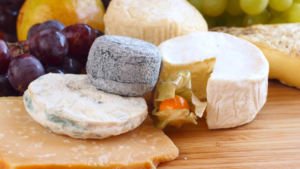
Several distinct families categorize French cheeses, each offering their own unique characteristics and flavors.
- Soft cheeses with bloomy rinds are perhaps the most recognizable, including world-renowned varieties like Brie and Camembert. The creamy interiors and velvety, edible white rinds of these cheeses come from Penicillium candidum mold. They often have buttery and earthy flavors that intensify with age.
- Washed-rind cheeses are known for their strong aromas and flavors. The washing process with solutions such as saltwater, brandy, or local spirits gives these cheeses their intense flavor and distinctive orange or red rinds. Examples include Munster and Epoisses, offering flavors from mildly pungent to deeply savory.
- Blue cheeses, such as Roquefort, Bleu d’Auvergne, and Fourme d’Ambert, are punctuated by veins of blue or green mold. These cheeses have a crumbly and sometimes creamy texture, with spicy, tangy, and even slightly sweet flavors that can vary in intensity.
- Hard cheeses, like Comté, Beaufort, and Mimolette, are aged for longer periods and are known for their firm textures. They have rich, complex flavors that can include nutty, sweet, sharp and fruity.
- Lastly, fresh cheeses such as Chèvre (goat cheese), fromage blanc, and faisselle are not aged. They have a soft, spreadable texture with mild, tangy flavors. Chefs find these cheeses very useful for cooking, often using them as ingredients in gourmet recipes.
5 Most Popular Types of French Cheese
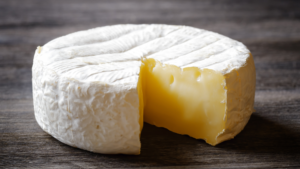
1. Brie
Often called the ‘Queen of Cheeses,’ Brie takes its name from the French region of its origin and stands out as a soft cheese. It’s known for its creamy, buttery flavor and smooth, edible rind. Brie is a versatile cheese, perfect for both cooking and as a staple on cheese boards.
2. Camembert
Similar to Brie, Camembert is a rich, soft, creamy cheese with a delicate, edible rind. Originating from Normandy, it has a deeper flavor compared to Brie, often described as earthy and intense. Camembert is traditionally sold in small, round wooden boxes.
3. Roquefort
Roquefort is a sheep’s milk blue cheese from the South of France, recognized for its strong, tangy flavor. It is one of the world’s best known blue cheeses and is notable for its greenish-blue mold veins. Roquefort is savory with a smooth, but still slightly crumbly texture.
4. Comté
Comté is a hard, unpasteurized cow’s milk cheese from the Jura region. Aged for at least four months, Comté is known for its complex flavors, which can include hints of nuttiness, sweetness, and even a subtle fruity taste. Comté is excellent for melting and is often used in traditional French dishes.
5. Chèvre
Chèvre is the French term for goat’s cheese. These cheeses can vary widely in texture and flavor but are typically tangy and slightly earthy. Chèvre is incredibly versatile and can be found in various forms, from fresh and soft to aged and firm.
Regions of different French cheeses
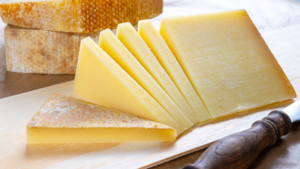
So…where does all this cheese come from? The differences in climate, vegetation, and local traditions throughout France have led to the development of distinct cheese varieties in each region.
In the lush, green pastures of Normandy, the moist, temperate climate is ideal for the production of soft, creamy cheeses like Camembert and Brie. The rich flavors and smooth textures, influenced by the high-quality milk from the region’s well-fed cows, make these cheeses highly beloved.
In contrast, the rugged, mountainous regions of the Alps and Pyrenees produce firm, hearty cheeses such as Comté, Beaufort, and Ossau-Iraty. These areas offer rich grazing for cows and sheep, and the cheeses reflect the hardy environment in which they are made. They have nutty and complex flavors that develop over months of aging.
Cheese from the South
The central and southern parts of France, with their warmer climates, are known for producing pungent, washed-rind cheeses like Munster and Roquefort. For example, the humidity and temperature of the caves where Roquefort ages contribute to its signature blue veins and sharp, tangy flavor.
Goat cheeses, or chèvres, are prevalent in the Loire Valley and Poitou-Charentes, where the mild, temperate climate and varied vegetation suit the dietary needs of goats. These regions produce cheeses like Crottin de Chavignol and Chabichou du Poitou, which vary from fresh and mild to aged and robust.
How French Cheese is Made
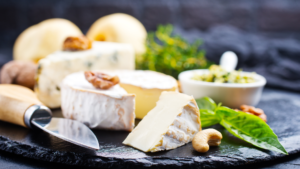
Milk Collection and Coagulation
The cheese-making process starts with collecting milk, usually from local cows, goats, or sheep. The milk is then heated and combined with rennet, which helps it coagulate. The type of milk and coagulation method significantly impact the cheese’s texture and flavor.
Curdling and Molding
Once the milk has coagulated, the curd is cut into various sizes, which further influences the cheese’s character. The curd is then placed into molds and pressed to remove excess whey, which is the remaining liquid after the cheese has been curdled and strained. This process helps define the cheese’s density.
Aging and Ripening
The next step is aging or ripening, which can last from a few weeks to several years. During this period, the cheese develops its unique flavors and textures. The conditions of the aging environment, such as humidity and temperature, are meticulously controlled to ensure the desired outcome.
Background on French Cheese
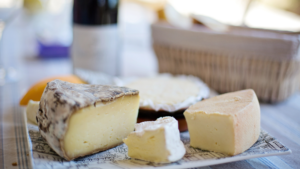
French cheese dates back to Roman times, but it was during the Middle Ages that cheese production began to resemble what we see today. Monasteries played a significant role in the early development of French cheese, as monks experimented with different methods of cheese-making. Local farmers then carried on the tradition, leading to the diverse range of cheeses we enjoy now.
Each region in France began to develop its own unique cheese, leading to a rich variety that reflects the local climate, culture, and culinary traditions. The importance of cheese in French culture is also evident in the Appellation d’Origine Contrôlée (AOC) system, which was established to preserve the traditional methods and origins of French cheeses.
French Cheese Boards
It would be impossible to write a guide on French cheese without mentioning cheese boards.
A French cheese board is not merely a selection of cheeses; it’s an art form and a reflection of balance and diversity. A well-curated cheese board should include a variety of textures and flavors, from soft to hard and mild to strong. Embellishments such as nuts, fruits, bread, and wine can enhance the experience, creating a harmonious blend of tastes and textures.
How to Make a French Cheese Board
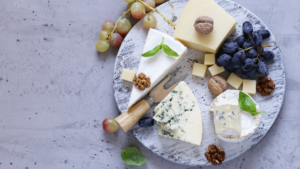
Creating the perfect French cheese board involves a combination of artistry and science. Here are some steps to guide you in the process:
Selection of Cheeses
Choose a range of French cheeses to showcase diversity. Include cheese formed from different types of milk and with various textures and flavors. A combination of Brie, Camembert, Roquefort, Comté, and Chèvre creates a well-rounded board.
Pairing and Presentation
Pair your cheeses with suitable accompaniments like fresh fruits, nuts, honey, and a selection of bread or crackers. Arrange the cheeses on the board from mildest to strongest, allowing guests to progress through different flavors.
Wine Pairing
Wine and cheese pairing is an essential aspect of the French cheese board experience. Select wines that complement the flavors of the cheeses. For example, a light, fruity white wine pairs well with soft cheeses like Brie and Camembert. Robust red wines typically complement the stronger flavors of Roquefort or Comté.
Serving Tips
Serve the cheese at room temperature to maximize flavor and texture. Provide separate knives for each cheese to prevent flavor mixing. It can be helpful to label each cheese so that guests know what they are tasting and can appreciate the diversity of French cheese culture.
In Summary
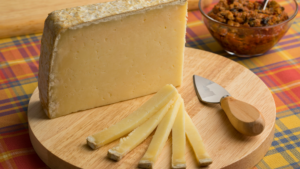
French cheese is more than just a culinary delight; it is a symbol of French heritage and artisan craftsmanship. From the lush pastures of Normandy to the rugged landscapes of the Pyrenees, the diversity of French cheese is a testament to the country’s rich regional and gastronomic history.
The next time you enjoy a piece of French cheese, remember that you are partaking in a legacy that is as old as France itself. Bon appétit!
Want to read more about France?
- A Brief Guide to Finding Jobs in France
- Want to live in France? Here’s your complete guide
- Discover the Best Festivals in France: Must-See Cultural Events
- Best thrifting and vintage shops in France
- Résiliation de bail in France – everything you need to know
Photo Credits:
- All photos used through Canva Free Media License